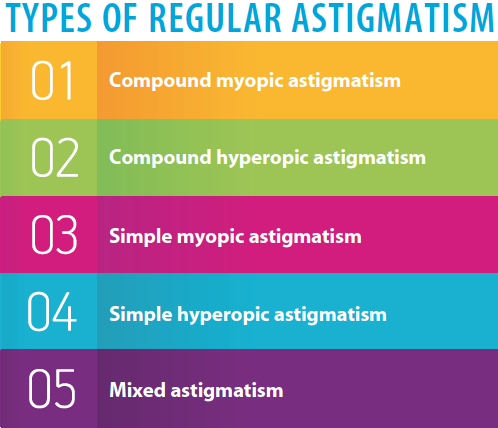
Cataract surgery has entered the arena of refractive surgery, and surgeons now aim for LASIK-like outcomes. To attain that goal, it is important to understand, diagnose, and treat astigmatism. This article delves into the basics of astigmatism, including the types of astigmatism, the methods of measuring it, and the importance of managing it.
BREAKING IT DOWN
Some degree of astigmatism is present in more than 90% of the global population, and nearly 50% of individuals worldwide have more than 0.50 D of astigmatism.1 Although the cause of astigmatism is not fully understood, theories suggest that genetics and mechanical interactions between the cornea, eyelids, and extraocular muscles may have an effect on its development.
AT A GLANCE
- Nearly 50% of individuals worldwide have more than 0.50 D of astigmatism.
- The cause of astigmatism is not fully understood, but genetics and mechanical interactions between the cornea, eyelids, and extraocular muscles may affect its development.
- Uncorrected astigmatism can result in blurred vision, diplopia, glare, ghosting, and asthenopia.
- The reduction of astigmatism during surgery can result in significant improvement in patients’ visual quality and uncorrected vision.
In an emmetropic eye, light that emanates from a distant point is focused to a point on the retina, creating a clearly focused image. Refractive errors such as myopia and hyperopia occur when the focusing power of the eye is too great or too little, respectively, for its axial length, resulting in a blurred image.
In eyes with astigmatism, refractive power is not uniform across all meridians; for example, light entering the eye may be focused more strongly along the vertical meridian than along the horizontal meridian. This difference in refractive power causes images to be smeared, so to speak, along the longer optical axis, resulting in blurred vision.
When the principal meridians of astigmatism (the highest and lowest refractive powers) are orthogonal to each other and refractive power is uniform across each meridian, the astigmatism is considered regular. Typically, regular astigmatism can be corrected with glasses or contact lenses. When the principal meridians are not orthogonal or the refractive power varies along a given meridian, the astigmatism is considered irregular. Irregular astigmatism is much more difficult to treat.
TYPES OF ASTIGMATISM
There are five types of regular astigmatism. In compound myopic astigmatism, the real images from each principal meridian are focused anterior to the retina. In compound hyperopic astigmatism, the virtual images from the principal meridians would be focused posterior to the retina. In simple myopic astigmatism, the image from the stronger principal meridian is focused anterior to the retina, while the image from the other principal meridian lies on the retina. Similarly, in simple hyperopic astigmatism, the virtual image of the weakest principal meridian is focused posterior to the retina, while the image from the other principal meridian is focused on the retina. Finally, in mixed astigmatism, the real image from the stronger principal meridian is focused anterior to the retina, and the virtual image from the weaker principal meridian lies posterior to the retina.2
Ocular astigmatism can originate at any of the major refractive interfaces of the eye: the anterior corneal surface, posterior corneal surface, anterior lens surface, or posterior lens surface. The refractive power of a refractive interface depends primarily on the curvature of that interface and the difference in the refractive indices of the materials on each side of the interface. Astigmatism occurs when the principal meridians of the interface have different curvatures. Because the anterior cornea is the refractive interface with greatest power, the analogy that an eye with astigmatism is shaped more like a football than a basketball is often used to explain this phenomenon to patients.
Corneal astigmatism is typically classified according to the location of its steepest meridian. In with-the-rule (WTR) astigmatism, there is greater refractive power (and increased curvature) along the vertical meridian than along the horizontal. Conversely, in against-the-rule astigmatism (ATR), the higher refractive power is along the horizontal meridian. In oblique astigmatism, the steepest corneal meridian is oriented at an oblique angle.3 Young adults typically display WTR astigmatism, and with increasing age there is a shift of astigmatism toward ATR. Internal astigmatism—the astigmatic contributions of the posterior cornea, anterior lens, and posterior lens surfaces—stays relatively stable over time.3

MEASURING ASTIGMATISM
Advances in technology and instrumentation have significantly improved our ability to measure and analyze the eye’s shape and optical properties, including astigmatism. Manifest refraction (retinoscopy) and wavefront analysis take the entire optical system into account and measure total astigmatism.4 Various technologies can be used to measure corneal astigmatism, including automated and manual keratometry, Placido-disc–based topography, Scheimpflug elevation mapping, and slit-scanning tomography. Placido-disc–based corneal topographers measure the anterior corneal curvature and estimate the contribution of the posterior corneal surface. Tomographic devices use elevation-based analysis of cross-sectional images of the cornea to measure curvature and, thus, can provide information on both anterior and posterior corneal astigmatism.
Current technologies can accurately measure anterior corneal astigmatism, and manufacturers are rapidly improving our ability to measure posterior corneal astigmatism. At this time, we can measure internal or lenticular astigmatism only indirectly, by subtracting corneal astigmatism from the eye’s total refractive astigmatism. The accuracy of all of these measurements rests on the status of the ocular surface and the composition of the tear film.
IMPORTANCE OF ASTIGMATISM MANAGEMENT
From a clinical standpoint, astigmatism management is important in both corneal laser vision correction (LASIK and PRK) and cataract surgery. Uncorrected astigmatism can result in blurred vision, diplopia, glare, ghosting, and asthenopia. In refractive surgery, the eye’s total refractive astigmatism is treated by changing the shape of the anterior corneal surface, and this has implications for cataract surgery in the future.
With increasing patient expectations, cataract surgery has become a refractive surgical procedure. To provide patients with spectacle independence and excellent visual outcomes, treatment of astigmatism is vital. Traditionally, the astigmatic contribution from the posterior corneal surface was ignored because it was presumed to be minimal, but studies by Koch et al showed that posterior corneal astigmatism is important in the determination of total corneal astigmatism.5,6 If corneal astigmatism measurements are based only on the anterior surface, this can lead to overestimation of astigmatism magnitude in WTR eyes and underestimation in ATR eyes.5,6 It is advisable to use more than one method (ie, automated keratometry and corneal topography or tomography) to measure corneal astigmatism and reconcile any disagreements among devices.
CONCLUSION
The reduction of astigmatism during surgery is critically important because it can result in significant improvement in visual quality and uncorrected vision for our patients. Surgical methods such as peripheral corneal relaxing incisions (performed either manually or with a femtosecond laser) can be used to correct astigmatism at the time of cataract surgery, as can the implantation of a toric IOL.7
Educating patients about astigmatism is important, especially if we expect a patient to pay a premium price for a toric IOL or a limbal relaxing incision. The concept of astigmatism is tough to explain to patients, which is why educational materials can be helpful. Brochures or websites with simulated vision images that represent blurriness secondary to astigmatism can assist us in explaining what astigmatism is. It can also be helpful to show color topography images when we talk to patients.
1. Lee BS, Lindstrom RL, Reeves SW, Hardten DR. Modern management of astigmatism. Int Ophthalmol Clin. 2013;53(1):65-78.
2. Riordan-Eva P. Optics & refraction. In: Riordan-Eva P, Whitcher JP, eds. Vaughan & Asbury’s General Ophthalmology, 17th ed. New York: McGraw-Hill Medical; 2007.
3. Read SA, Collins MJ, Carney LG. A review of astigmatism and its possible genesis. Clin Exp Optom. 2007;90(1):5-19.
4. Mozayan E, Lee JK. Update on astigmatism management. Curr Opin Ophthalmol. 2014;25(4):286-290.
5. Koch DD, Ali SF, Weikert MP, et al. Contribution of posterior corneal astigmatism to total corneal astigmatism. J Cataract Refract Surg. 2012;38:2080-2087.
6. Koch DD, Jenkins R, Weikert MP, Yeu E, Wang L. Correcting astigmatism with toric intraocular lenses: the effect of posterior corneal astigmatism. J Cataract Refract Surg. 2013;39(12):1803-1809.
7. Lee H, Kim T, Kim EK. Corneal astigmatism analysis for toric intraocular lens implantation: precise measurements for perfect correction. Curr Opin Ophthalmol. 2015;26(1):34-38.


